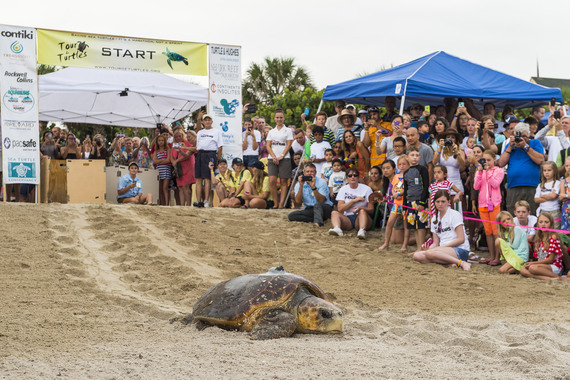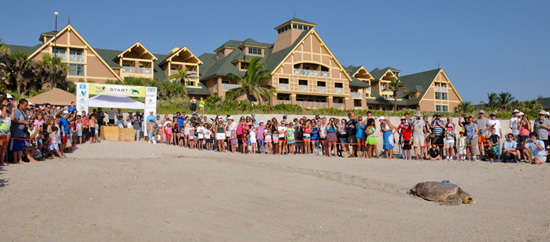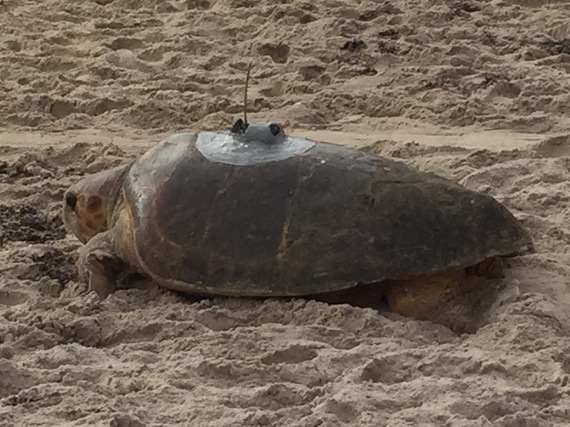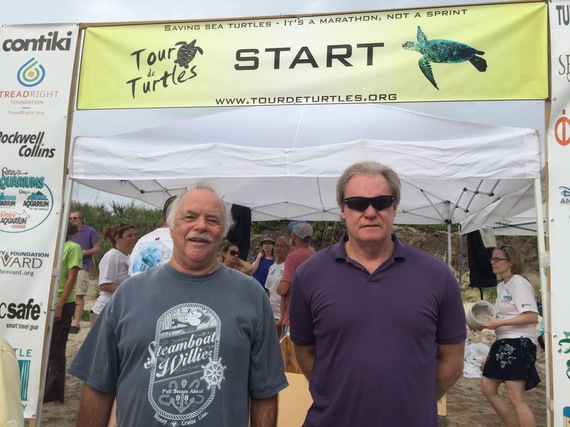This is the third year I participated in the Tour de Turtles event and the 8th year of the race. Each year I have learned more about the challenges facing the sea turtles who all are either on the threatened, endangered, or critically endangered list. Perhaps more importantly, I am learning that the strategies that are being used to save the sea turtles are a good metaphor for the strategies needed to save human beings as well.
This year 13 turtles began the race from Florida (6), Panama (1), Costa Rica (4), and Nevis (2).
Each turtle is racing 90 days for a different cause. A summary of the causes are as follows:
Boat Strikes - turtles killed from boats or their propellors striking turtles as they surface.
Water Quality - turtles can become sick or infected from water pollution particularly chemical fertilizers from lawns, and agriculture that run off into the streams that feed the bays, estuaries, and oceans.
Plastic Debris - 90% of the ocean's pollution comes from plastic due to its slow rate of decomposition. Many turtles that have been killed by consuming debris had plastic bags or fishing lines in their stomachs, some pieces as small as half of a fingernail.
Light Pollution - Light pollution is a problem for both turtles that are laying their eggs and the hatchlings being born. Bright lights discourage turtles from coming ashore to lay their eggs. Once born bright lights from condos, hotels, or other development can disorient the new born hatchlings and direct them away from the ocean. Turtle hatchlings have an instinct that leads them in the brightest direction which is usually the moonlight reflecting off of the oceans.
Climate Change - Climate change threatens the sea turtles nesting habitat with sea level rise. Warmer water may drive sea turtles to find new areas with colder waters, and the temperature of the sand may change the ratio of male and female turtles.
Commercial Trawl Fisheries - Each year 250,000 sea turtles are accidentally captured, injured, or killed by fishermen. Many of these accidents come from the practice of trawling.
Egg Harvest Consumption - The problem comes from egg poachers who take the turtle eggs out of the nests and sell them for consumption.
Illegal Sea Shell Trade - This is a problem particularly for the Hawksbill turtle whose beautiful gold and brown shells are hunted to make jewelry and other luxury items.
Commercial Long Line Fisheries - Migrating turtles often encounter fishermen's longlines. A longline consists of a mainline 40 or more miles long with thousands of additional lines and hooks attached to it. The turtles either eat the bait and get hooked or become entangled in the lines.
Invasive Species Predation - Human development brings trash to the beaches which in turn brings raccoons who also are predators to turtle eggs and hatchlings. Dogs and cats can be predators as well.
Beach Erosion - Beach erosion is often addressed through beach nourishment. The problem arises when the sand is compacted too hard for the turtles to nest.
Coastal Armory - Coastal armoring structures such as sea walls on or adjacent to nesting beaches can prevent sea turtles from continuing their life cycles. Sea walls directly threaten sea turtles by reducing or degrading suitable nesting habitat. They block turtles from reaching the upper portion of the beach, causing turtles to nest in less-than-optimal nesting areas lower on the beach where their nests are more susceptible to wave action and more likely to by covered with water.
So the race is on and each or you can pick or adopt your favorite turtle to cheer on and track them for the rest of the 90 day race, Track the turtles online.
Learn more about Tour de Turtles from my interview with Lexie Beach, Director of Communications for the Sea Turtle Conservancy.
I
Responding to the Challenge
According to the Florida Fish & Wildlife Conservation Commission, 80% of the global loggerhead population nests in either Florida or in Oman in the Arabian Peninsula. Florida accounts for 90% of U.S. Loggerhead nesting.
Over 90% of a sea turtles life is at sea. Tracking these turtles allows scientists to learn their the ocean environment, what they are eating, and how best to protect them.
The 20.5 miles from Melbourne Beach to Wabasso Beach is where 35% of the world's loggerhead sea turtles nest. The Disney Vero Beach Resort is along this stretch of critical habitat and they have become global leaders in modeling how tourism can protect and enhance sea turtle habitat.
The Florida Fish & Wildlife summarizes the challenge when it states:
"In Florida, coastal development and high vessel traffic present challenges for sea turtle protection. Artificial lighting on nesting beaches causes hatchlings from nests to crawl inland rather than toward the water. On developed beaches, coastal armoring meant to protect buildings from erosion has eliminated nesting habitat where natural dunes once stood. Throughout the state's waters, collisions with boats are the most common identifiable cause of trauma in sea turtles that wash up dead on Florida beaches."
The Walt Disney Company has responded to this challenge by providing $2 million through the Disney World Conservation Fund to protect sea turtles.
The Disney Vero Beach Resort hosts the Tour De Turtles event sponsoring two turtles each year but does much more throughout the year.
The Disney Vero Beach Resort was one of the first to install turtle friendly lighting and has a solid program in place to educate guests to close their drapes and/or turn off lights during the turtle nesting season.
The landscaping of the Disney Vero Beach Resort assists in reducing lighting and is a viable alternative to more damaging coastal armoring structures.
Disney also makes sure that their beaches are clean, that all beach chairs and umbrella's are brought in each night.
The Disney Vero Beach does not allow plastic straws or lids at the resort. Plastic can look a lot like jelly fish to sea turtles, and straws can easily be mistaken for sea grass.
Disney's research team covers about 7 miles of the 20 mile stretch of critical habitat, conducting nesting surveys, and research on how well turtles are doing under these conditions.
Disney also invites guest participation. They offer a 7:00 a.m. experience on the beach to find new turtle nests which are then marked by the Disney team. They also have guided sea turtle night walks where guests can watch the sea turtles lay their eggs. I was fortunate enough this trip on one of my evening beach walks to observe a nest of of turtle hatchlings come out of the nest and race to the sea.
Learn more about the Walt Disney's sea turtle conservation, by watching my interview with Dr. Anne Savage, the Walt Disney Company Conservation Director for Walt Disney World Parks & Resorts.
Science, Policy & Education
The Sea Turtle Conservancy has combined science, policy, and education, to protect the sea turtles. Based in Gainesville, Florida, where its founder Archie Carr taught at the University of FLorida , School of Zoology. Considered one of the world's foremost sea turtle experts, Dr. Carr persuaded the Costa Rican government to establish the Tortuguero National Park where the Sea Turtle Conservancy monitors sea turtles.
In 1978 the U.S. Congress passed the Endangered Species Act that was the impetus for NOAA to begin work to protect the endangered sea turtles.
In 1991, the Archie Carr National Wildlife Refuge was established to encompass the 20.5 miles of critical habitat for the Loggerhead turtle. This policy decision not only protected the Loggerheads but also the Green turtles and provided an area for scientists to better study turtle habitats.
With the wildlife refuge established scientists began counting Loggerhead nests and occasionally came across a few Green Turtle nests in the process.
In the early 90's less than 50 Green Turtle nests were counted. Last year that number topped 12,000 nests, making it one of the most remarkable comeback success stories of any endangered species.
The success is attributed to many factors including:
- The Endangered Species Act that directed resources and programs to protect the Sea Turtle
In 2008, the Barrier Island Sanctuary was opened through the partnership with the Richard K. Mellon Foundation that donated the land, Brevard County, and the Sea Turtle Conservancy. The Sea Turtle Conservancy operates the Center to provide education and research about sea turtles in the heart of the Archie Carr National Wildlife Refuge.
The need for continued science, protection, and education continues.
For example, a new study shows that the Hawksbill sea turtle are migrating to deeper and cooler waters in the Arabian Sea as temperatures increase.
With water temperatures getting up to 98 degrees and air temperatures 122, the hawksbill are changing their habits.
Turtle tracking will help determine new patterns for the loggerheads and green turtles who nest in Florida. There are many unanswered questions that researchers need to monitor. For example, what If Florida turtles have to move north to nest due to sea level rise and/or temperature increase. Are there new habitats even available? What if the sand temperature increase changes the ratio of male and female hatchlings so that reproduction rates are reduced? The temperatures of the sand will determine the sex of the hatchlings and if too hot, can even destroy the eggs.
Science, policy, and education have made incredible strides in saving the sea turtles. New science, policy, and education will be needed if this success is going to continue.
Listen to my interview with Dr. Emma Harrison, Scientific Director of the Sea Turtle Conservancy, to learn more.
We All Can Do Something
In recent years I have come to believe that the strategies and ethic needed to protect the sea turtles are the very strategies and ethic that are needed to protect humans as well.
In the past few years, internationally renowned scientists have introduced a framework for nine planetary boundaries within which humanity can continue to develop and thrive for generations to come. Crossing these boundaries could generate abrupt or irreversible environmental changes. Respecting the planetary boundaries reduces the risks to human society of crossing these thresholds.
Many of these nine planetary boundaries are the same issues that are being addressed by Tour de Turtles including:
- Reducing biodiversity loss - All sea turtles are currently on the threatened, endangered, or critically endangered list.
"In the coral reefs with which hawksbills are closely associated, increased water temperatures and acidification will undermine the ability of coral polyps to survive and build reefs. Because some species of fish are losing their olfactory sensibility and homing ability in more acidic waters, the potential exists for sea turtles to suffer the same fate."
Very few, if any of us, can address all these issues. We may not be able to do everything but we can all so something.
Whether it is protecting the natural environment, keeping beaches clean, making sure beaches are dark at night, protecting turtles natural habitat, reducing our use of fertilizers, or adopting a turtle in the Tour de Turtles race, we can all do something.
My friend Bill Smilie, author of Edgework and Random Crimes, and a teacher for an inner city school in the Phoenix area, joined me this year at the Tour de Turtles event and reflected on how he was going to make a difference where he teaches.
"Over the weekend of August 1st and 2nd, I was fortunate enough to witness the release of four Loggerhead turtles from the shores of Vero Beach as the final chapter unfolded in the 2015 Tour de Turtles. The following Monday evening as I walked the beach just north of the Disney resort, I came upon a nest of Loggerheads that had just hatched and watched in amazement as the tiny hatchlings scampered in a frenzied run born in time immemorial over the sand toward the surf and the sea. When my high school classes commence in a few short weeks, I will share this experience in film and narrative with my students, most of whom (if not all) have never seen a giant sea turtle up close and personal nor witnessed the cycle of life displayed so poignantly on the beaches at Vero. Aside from the advancement of the science of environmental conservancy and awareness of all things oceanic, this little event will hopefully resonate within a roomful of inner-city youth of a need to look beyond the streets and the avenues to a big wide world breathing with labored effort into a future of uncertainty and daring hope."
In my interview with David Godfrey, Executive Director Sea Turtle Conservancy, David reflects on actions the public can take.
My small part is writing this article. I look forward to your comments and examples of what you will do.
Together we can make a difference.
Please consider supporting the Sea Turtle Conservancy and the Disney Worldwide Conservation Fund, as way to keep the work to protect sea turtles going year round.
I hope that next year many of you may attend the Tour de Turtle event which is nothing less than an inspiring reminder of how we are all connected to nature and each other.
Dr David W. Randle - Director USF Patel College of Global Sustainability Sustainable Tourism, Managing Director International Ocean Institute Waves of Change Blue Community Initiative, and President & CEO WHALE Center.
Follow David Randle on Twitter



